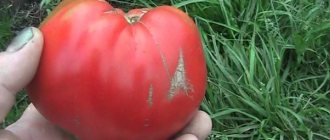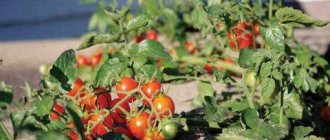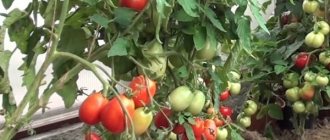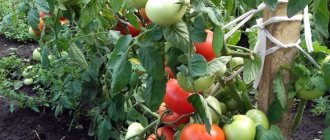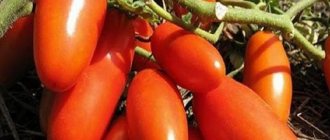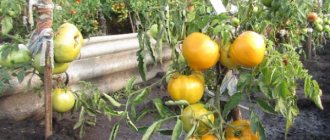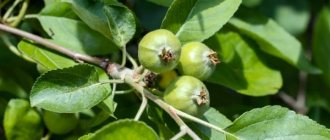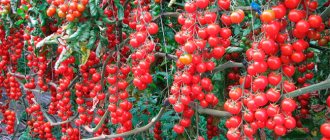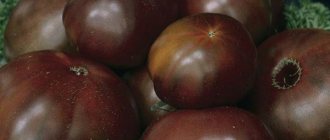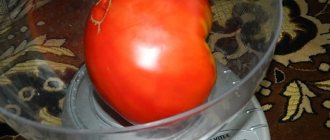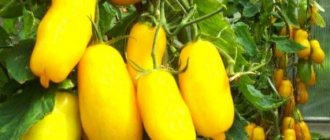How to care for bushes
In order for tomatoes to produce a good harvest, they must be looked after.
Pay attention to the following content elements: . Watering
Watering
Please note that watering young plants for the first couple of weeks after planting is not recommended. First, the bushes must be firmly rooted. Be careful about watering during the period of fruit formation and ripening. Do not allow the soil to dry out.
The soil
Plants need slightly acidic or neutral soil. In case of increased acidity, additional lime is added to the soil.
Loosening and weeding
It is important that the soil is loose. Loosening will help retain moisture and provide oxygen access
Don't neglect this element of care. Get rid of weeds from plants in a timely manner.
Fertilizers
Tomato responds well to fertilizing. At the active growth stage, nitrogen fertilizers are needed to stimulate the development of greenery.
During the flowering period, products containing phosphorus and potassium are used. These elements contribute to the rapid formation of ovaries and fruit growth.
Garter and stepson
Apples in the snow do not have to be tied up or pinched. Procedures are carried out at the request of the owner.
Prevention
Since the variety is susceptible to the development of late blight, it is necessary to pay attention to prevention. Weed out weeds in a timely manner and ventilate greenhouses properly. Mulching the soil with peat has a good effect.
Avoid overfeeding with fertilizers. Periodically treat the bush with special products (Ridomil). If the plant is affected by a disease, it will have to be removed.
Description
This is a determinate, very compact plant. The height of the bush is no more than 50 cm. The strong trunk is moderately covered with small dark green leaves. The tomatoes are small, round, bright red. During the fruiting period, the bush looks very decorative. Therefore, many people grow “Apple Tree in the Snow” not only in the country, but also in flowerpots on the balcony.
When planting seeds for seedlings in early March, the first tomatoes ripen at the end of June. They are formed with brushes from 5 to 7 pieces on each. With good care, you can harvest up to 2.5 kg of harvest from one bush. The variety is universal in use. Suitable for preparations - juices, purees, preservation. And for fresh consumption.
Advantages and disadvantages
This tomato is practically immune to viral infections; it is not afraid of diseases such as tobacco mosaic, fusarium or tomato streak. A small disadvantage is that the resistance to late blight is insufficient. But given the early ripening of the variety, this problem practically does not affect the crop: it ripens until the moment when the disease has time to spread and cause any damage.
Advice. Competent agricultural technology, timely fertilizing, straw mulch and regular weeding protect the plant and increase its resistance and vitality.
The main advantages of tomatoes of this variety:
- Precocity.
- Immunity to infections.
- High yield.
- Universal use of fruits.
- Great taste.
- Beautiful appearance.
- Simplicity of agricultural technology.
Flaws:
- The fruits are small.
- Temporary instability to late blight.
Description of the tomato variety Apples on the snow, its characteristics and yield
Reviews from people who grow vegetable crops talk about looking for tomatoes that can withstand sudden changes in weather conditions. For residents of cold regions, the Apples on the Snow tomato variety is suitable. They are not only grown in harsh climatic zones, but also have stable immunity to tomato diseases. Apples in the snow is an original variety that was bred by breeders from Russia.
More about tomato
The characteristics and description of the tomato variety Apples on the Snow are simple and do not contain information that would be incomprehensible to a gardener. Universal vegetables are suitable for growing in open ground and in greenhouses. Those who like to eat fresh tomatoes in early spring plant them in pots and take them out onto balconies or loggias. Low-growing bushes do not cause much trouble, as they are characterized by compactness.
Apples in the snow are an early-ripening variety characterized by productivity. The bush has a minimum number of leaves. The height of the determinate plant varies between 65 cm. The small leaves are rich green in color, and the stem is several tones lighter.
Fruits and harvest
To increase the yield of the crop, pinching is carried out, thereby forming a bush. Simultaneous ripening of fruits occurs on one bunch. There can be from 4 to 8 pieces on a branch. At the time of fruiting, the plant looks beautiful. 50 pieces are collected from one bush, with most of them being selected - from 30 to 37 pieces.
The weight of the fruit does not exceed 70 g. They are small, they have a round shape, slightly flattened in the area of the stalk. There are no spots or excessive ribbing near the stem. The skin covering the pulp is thin. At the same time, it has good density and prevents tomatoes from cracking from excessive moisture in the form of precipitation.
When tomatoes ripen, they have rich red flesh. It is dense, but remains juicy. Despite its small size, there are many chambers inside the tomato. Sweetish, light and pleasant taste has subtle sour notes.
Advantages and disadvantages of the variety
Tomatoes stand out from other varieties with the following number of advantages:
- fruits the size of a walnut will appeal to gourmets, and will also delight children with their size;
- They are distinguished by early ripening of the harvest; they enjoy fresh vegetables already in mid-June;
- immunity remains stable due to its protective properties;
- one bush brings 50–75 ripe tomatoes;
- are not susceptible to parasitism by pests.
In contrast to its advantages, the variety has only one drawback - in rare cases it can avoid late blight. Apart from this point, there are no other negative aspects with culture.
Snow apples can be eaten in any form - fresh, as one of the ingredients in a salad, or preserved for the winter. It will be an excellent side dish for fish or meat dishes. The bright color of the tomato will help you create assorted vegetables in a jar. Fresh tomatoes are stored for a long time. Therefore, they can delight the whole family until autumn.
Tomato Apples on the snow variety description
| Variety name | Apples in the snow |
| general description | An early-ripening, determinate variety of tomatoes for growing in greenhouses and open ground. |
| Originator | Russia |
| Ripening period | 90-100 days |
| Form | Round, slightly flattened, without pronounced ribbing |
| Color | Red |
| Average weight of tomatoes | 50-70 grams |
| Application | Tableware, for canning |
| Productivity of the variety | 2 kg per bush |
| Features of cultivation | Standard agricultural technology |
| Disease resistance | Resistant to major tomato diseases |
Tomatoes Apples on the Snow are an early-ripening, very productive variety.
The bush is determinate, compact, with a moderate amount of green mass. Read about indeterminate varieties here. The height of the plant is no more than 70 cm. The leaves are small, dark green. For greater yield, it is recommended to form a bush using light pinching. The fruits ripen in clusters of 5-7 pieces. During fruiting, the plant looks very elegant. From one bush you can collect 30-35 selected tomatoes.
You can see the yields of other varieties in the table below:
| Variety name | Productivity |
| Apples in the snow | 2.5-3 kg per bush |
| Lazy | 15 kg per square meter |
| Summer resident | 4 kg per bush |
| Doll | 8-9 kg per square meter |
| Fat Jack | 5-6 kg per bush |
| Andromeda | 12-20 kg per square meter |
| Honey Heart | 8.5 kg per square meter |
| Pink Lady | 25 kg per square meter |
| Lady Shady | 7.5 kg per square meter |
| Gulliver | 7 kg per square meter |
| Bella Rosa | 5-7 kg per square meter |
The fruits are small, even, weighing 50-70 g. The shape is round, slightly flattened, without pronounced ribbing or spots on the stalks. The skin is thin but dense, well protecting the tomatoes from cracking. Ripe fruits have a bright red color. The pulp is dense and juicy, there are many seed chambers. The taste is pleasant, sweet, with barely noticeable sourness.
You can compare the weight of fruits with other varieties of tomatoes in the table below:
| Variety name | Fruit weight |
| Apples in the snow | 50-70 grams |
| Bobcat | 180-240 grams |
| Russian size | 650 grams |
| King of Kings | 300-1500 grams |
| Long Keeper | 125-250 grams |
| Grandma's gift | 180-220 grams |
| Brown sugar | 120-150 grams |
| Rocket | 50-60 grams |
| Altaic | 50-300 grams |
| Yusupovsky | 500-600 grams |
| De Barao | 70-90 grams |
Description of the Siberian Apple tomato and apple series varieties
The Siberian Apple tomato belongs to the selection of Russian agrobiologists. A mid-season, high-yielding variety intended for cultivation in greenhouses and open ground.
Advantages of the variety
Siberian Apple tomatoes are distinguished by their high yield and beautiful appearance. The average early variety begins to bear fruit 115 days after the appearance of friendly shoots.
The characteristics and description of the variety indicate the possibility of growing the crop in open ground and greenhouses. During the growing season, a bush with a height of 150-180 cm is formed.
The plant is abundantly loaded with fruits, the weight of which reaches 200 g. At the stage of technical maturity, tomatoes have a whitish color. During the ripening process, the fruits acquire a pink color with a pearlescent tint.
Tomatoes with dense, fleshy pulp retain commercial quality on the bush and during storage. The fruits contain a high concentration of vitamin C and sugar, which determines the sweet and sour taste. With a horizontal cut, 4-6 chambers with seeds are observed.
The average yield is 9 kg per 1 m². The variety is resistant to diseases, which makes it popular among gardeners.
Characteristics of the apple series
Among the tomatoes that have gained popularity among vegetable growers is the Apple tomato and its varieties. The versatile fruits have a pleasant taste and can be stored for a long time.
Anyone who planted Apple Tomato notes the average early ripening period, the universal purpose of the product. Tomato Apples on the snow belongs to the determinant type.
On a bush 60 cm high, up to 35 fruits weighing 50 g ripen. Up to 3 kg of tomatoes are harvested from the plant, which are distinguished by their uniform color and long shelf life. Medium-sized tomatoes have a height of up to 1 m. These include Malinovka Apple, with raspberry-colored fruits.
The yield per bush reaches 5 kg. The Apple Spas variety is resistant to diseases of nightshade crops. The fruits are universally used and can be transported over distances.
The Golden Apple tomato is suitable for cultivation in various conditions. The fruits are yellow, round in shape, hidden under the bright green leaves. Tomatoes of the Emerald Apple variety at the ripe stage have an intense green color.
Paradise Apple and Cherry tomatoes are small-fruited varieties of tomatoes. The new tomato-apple hybrid Red Love is a fruit tree. The flower stalks are shaped like apple trees, and ripe fruits have the appearance of a tomato.
Agricultural cultivation technology
Sowing seeds for seedlings is carried out 50-60 days before the expected date of planting in the ground. To speed up the process of seed germination, improve the health of the crop, and ensure better fruit set, it is recommended to treat the seeds with growth stimulants.
For seed germination, maintaining an optimal temperature of +23...+25°C is required. In the phase of formation of 2 true leaves, a dive is carried out. For this purpose, peat pots are used, with which the seedlings are transferred to a permanent place.
Further care of the seedlings consists of timely weeding and loosening the soil. For normal development of the plant and ensuring high yield from the bush, it is recommended to fertilize the roots with complex mineral fertilizers.
The bushes grow into 1-2 stems, remove excess shoots, and tie them to a support or trellis. To ensure optimal soil moisture, non-woven black fiber is used.
Mulching the soil prevents the growth of weeds and protects the surface layer of soil from drying out.
Opinions and recommendations of vegetable growers
Reviews from vegetable growers about the Siberian apple variety are associated with high yields.
Lyudmila Egorova, 56 years old, Biysk.
I grew Siberian apple tomatoes last season. I planted the bushes in a greenhouse. Throughout the growing season, I tried to maintain optimal air temperature and the required level of humidity. The variety fully corresponds to the description, is characterized by high yield, and bears fruit for a long period of time. Ripe tomatoes have a neat shape, beautiful color, and excellent taste.
Planting tomato seedlings in the soil
In May, seedlings are planted in greenhouses, unheated greenhouses. The depth of immersion in the ground is 10 cm. When the threat of spring return frosts has passed, the shelter can be removed. The distance between plants is of great importance for the prevention of late blight. Early ripening varieties are recommended to be planted according to a 30x40 pattern. But due to the variety’s tendency to late blight, it is best to plant them according to the 70x70 pattern. If there is little space, the distance in the row can be reduced to 50 cm. They are planted in open ground in the northern regions, for which the variety is intended, in mid-June. They focus on the possibility of frost, which tomatoes cannot tolerate.
In the northern regions, it is better to plant tomatoes on southern slopes, protected from cold northern winds. The soil must meet certain requirements. Do not plant tomatoes after nightshades, including eggplants and peppers. It is better to use the area where cabbage, pumpkin, etc. grew last year.
Soil acidity should be neutral or weakly acidic (pH 6.0-6.7).
If the soil on the site is acidic, it needs to be limed by adding lime or dolomite flour. A week before planting the plants, the area is watered with Baikal EM1 fertilizer. It promotes the formation of microorganisms beneficial to tomatoes.
When planting plants, they are immersed in the soil up to the lower (not true) leaves. If the plants are very tall, overgrown or elongated, lay them on their sides, with their tops facing south. Urgas fertilizer (half a teaspoon) is applied to the bottom of the hole. Water, wait until the water is absorbed and sprinkle with soil a third or fourth of the length of the trunk.
More about tomato
The characteristics and description of the tomato variety Apples on the Snow are simple and do not contain information that would be incomprehensible to a gardener. Universal vegetables are suitable for growing in open ground and in greenhouses. Those who like to eat fresh tomatoes in early spring plant them in pots and take them out onto balconies or loggias. Low-growing bushes do not cause much trouble, as they are characterized by compactness.
Apples in the snow are an early-ripening variety characterized by productivity. The bush has a minimum number of leaves. The height of the determinate plant varies between 65 cm. The small leaves are rich green in color, and the stem is several tones lighter.
Diseases and pests
Despite the presence of good immunity, the “Apples in the Snow” tomato is susceptible to late blight. As preventive measures, timely destruction of weeds and ventilation of greenhouse structures are carried out. The bushes are sprayed with copper-containing preparations. All affected parts of the plant are immediately torn off and burned.
Of particular danger to the variety are thrips, aphids, Colorado potato beetles, and spider mites. Preventative spraying of bushes is carried out with a weak manganese solution. If the insect population is high, the use of industrial insecticides will be required. A soap solution used to wash stems and leaves is effective against aphids.
Growing tomatoes in the country
Before planting tomatoes in open ground, sowing and growing seedlings indoors is carried out. For better germination, the seeds are pre-soaked in salt water.
The soil chosen is loose and nutritious. A mixture of leaf soil and humus is used as soil. Seeds are planted in containers, immersed to a depth of 1.5-2 cm. Germination is carried out at a temperature of 22-24°C.
To create optimal conditions, the container is covered with film. Experienced vegetable growers recommend treatment with a growth stimulant to speed up the emergence of seedlings.
The container with the sprouts is placed in a well-lit place and regularly sprayed with heated water. After several leaves appear, the seedlings can be planted in different pots. Ready-made complex fertilizers will not interfere.
In the first days of May, seedlings can be planted in greenhouses. Plants are moved to open ground when the threat of night frosts has passed. As a rule, this occurs no earlier than the end of May.
The bushes are not planted tightly. With a small distance between tomatoes, the growth and ripening of the crop slows down.
Be responsible when choosing a landing site. It is undesirable to plant tomatoes in the same area for two years in a row.
They also choose their neighbors carefully. Gardeners do not recommend placing tomatoes near potatoes or eggplants. A combination of carrots, onions, beans or pumpkin is suitable.
An original variety of large-yield tomato Apples on the snow description, characteristics, photos
Fans of compact bushes and small-fruited, tasty tomatoes will certainly like the original Apples on the Snow variety.
These plants are good for greenhouses or open beds, they feel great in large pots on window sills and balconies.
Tomato Apples on the Snow is an early-ripening, very productive variety.
The bush is determinate, compact, with a moderate amount of green mass. The height of the plant is no more than 70 cm. The leaves are small, dark green.
For greater yield, light pinching with the formation of a bush is recommended. The fruits ripen in clusters of 5-7 pieces. During fruiting, the plant looks very elegant. From one bush you can collect 30-35 selected tomatoes.
The fruits are small, even, weighing 50-70 g. The shape is round, slightly flattened, without pronounced ribbing or spots on the stalks. The skin is thin but dense, well protecting the tomatoes from cracking.
Ripe fruits have a bright red color. The pulp is dense and juicy, there are many seed chambers. The taste is pleasant, sweet with barely noticeable sourness.
Origin and application
The Russian tomato variety Apples on the Snow was bred by amateur breeders and is intended for cultivation in greenhouses, greenhouses, and open ground.
Compact bushes can be planted in large pots for placement on verandas, loggias, and glazed balconies. Despite their miniature size, tomatoes have good yields. Harvested tomatoes are stored well.
Small fruits with thin but strong skin are excellent for canning. They can be included in assorted vegetables, used for salads, side dishes, and to decorate dishes. Small bright red tomatoes Children love apples in the snow.
Advantages and disadvantages
Among the main advantages of the variety:
- very early ripening, the first tomatoes are harvested at the end of June;
- delicious small fruits that children love;
- excellent yield;
- resistance to major nightshade diseases.
The variety has practically no disadvantages. The only problem may be susceptibility to late blight.
Photo
See below: tomatoes Apples in the snow photo
Features of cultivation
Tomatoes variety Apples on the Snow are sown as seedlings in the first half of March. It is better to treat the seeds with a growth stimulant, which significantly improves germination.
Plants need lightweight, highly nutritious soil, consisting of a mixture of garden soil and humus. Seeds are sown in containers with a depth of 2 cm, sprayed with water and covered with film.
After germination, the containers are exposed to bright light. Plantings should be watered with warm, settled water, using a fine-mesh watering can or spray bottle.
When the first pair of true leaves unfold, the plants dive into separate pots. Then the tomatoes are fed with complex fertilizer. It is recommended to feed weak shoots with nitrogen-containing preparations (for example, urea).
Planting in a greenhouse or pots is carried out in the first half of May. Tomatoes are moved to open beds closer to June, when the soil has completely warmed up. For 1 sq. m you can place no more than 4 bushes. Too many rows prevent tomatoes from developing and fruiting slows down.
During the season, plants are fed 3-4 times with mineral fertilizers based on phosphorus and potassium. The bush is slightly pinched; the lower leaves can also be removed.
Apples in the snow is a tomato variety that is quite resistant to viral diseases, for example, tobacco mosaic.
However, it may be susceptible to late blight. For prevention, it is recommended to pull out weeds in a timely manner and ventilate the greenhouse.
The soil can be mulched with peat or straw.
Plants are sprayed with copper-containing preparations, the affected leaves and fruits are promptly destroyed and then burned.
Of the insect pests, thrips, whiteflies, aphids, and spider mites are especially dangerous.
For prevention, you can spray the plants with a pale pink solution of potassium permanganate.
In advanced cases, industrial insecticides will help. A soap solution used to wash the stems and leaves helps against aphids.
Small-fruited tomatoes Apples on snow are an excellent option for canning and decorating dishes.
By planting several miniature bushes in a greenhouse or flowerpot, you can please your family with tasty and healthy fruits that will ripen in June.
Useful video
Watch the video: how to deal with late blight
Origin and application
The Russian tomato variety Apples on the Snow was bred by amateur breeders and is intended for cultivation in greenhouses, greenhouses, under film, and in open ground.
Compact bushes can be planted in large pots for placement on verandas, loggias, and glazed balconies. Despite their miniature size, tomatoes have good yields. Harvested tomatoes are stored well.
Small fruits with thin but strong skin are excellent for canning. They can be included in assorted vegetables, used for salads, side dishes, and to decorate dishes. Small bright red tomatoes Children love apples in the snow.
Caring for tomatoes Apples in the snow
The main task when caring for “Apples in the Snow” tomatoes is to provide the required amount of moisture before flowering, during the formation of the ovary and before ripening. In this case, it is necessary to create conditions for the free movement of air between the bushes. It will carry away excess moisture, preventing the development of late blight.
Whether tomatoes need pinching and tying to supports - each owner decides for himself. Determinate varieties, which include “Apples in the Snow,” can be grown without these procedures. But if there is a threat of late blight, it is better to regulate the number of stems and leaves. And to ensure that the fruits do not lie on the ground, use low supports.
Care Tips:
- The soil on the site must be kept free of weeds. After all, they take a large amount of useful substances from plants and contribute to the development of late blight. Loosening the soil helps lock in moisture after watering.
- Regular fertilizing increases the yield of tomatoes. You can use diluted infusion or chicken manure. To do this, a liter of dry fertilizer is diluted in 10 liters of water. Leave in a warm place for a week. Then add a liter of infusion to a bucket of water and pour a liter of liquid under each bush. Before and after fertilizing, plants need to be watered. It's good if it rains.
- Tomatoes respond well to fertilizing with mineral fertilizers. They are carried out 3 weeks after planting and during the period of mass formation of fruits (another 3 weeks). 25 g of ammonium nitrate, 40 g of superphosphate, 15 g of potassium fertilizers are diluted in a bucket of water. This amount is enough for small plants for 15 bushes, and for adults – for 7. Phosphorus fertilizers improve the process of flowering and fruit formation. In the second half of summer you need to be careful with nitrogen fertilizers. When it gets colder, they can cause the ovaries to fall off.
- If tomato leaves curl and the edges dry out, this indicates a lack of potassium. The fruits become light near the stalk, and voids form inside. If the plant lacks nitrogen, the leaves become small and light-colored. The plant reacts to a lack of phosphorus with purple leaves. They rise up, clinging to the trunk. Fertilizing with organic matter and mineral fertilizers alternates.
- You should not get carried away with excessive watering of tomatoes. This can lead to the development of fungal diseases. Plants should receive the main amount of moisture during the period of mass formation of ovaries. Treated with Fitosporin or others intended for the prevention and control of fungal diseases.
The fruits are harvested as they ripen. You can pick brown tomatoes and put them in boxes. This will speed up the ripening period of all fruits from the bush.
More information can be found in the video:
Description of the Apple Lipetsk tomato variety, growing by seedling method and caring for bushes
The Apple Lipetsk tomato is intended for use in salads. The plant has an average ripening period. It is possible to use the fruits for juice production, and the smallest specimens are suitable for preservation.
The described variety is grown in open areas in the southern regions of Russia. If a vegetable grower lives in the middle zone, then a film greenhouse is required to obtain a harvest.
In Siberia and the Far North, the Lipetsk apple variety is grown in greenhouses or well-heated greenhouse blocks.
Characteristics and description of the variety
The characteristics and description of the variety are as follows:
- The vegetative period of plant development from germination to the first fruits lasts 110-115 days.
- The height of the bushes of the described tomato when grown in an open area reaches 150-160 cm. If the farmer uses a greenhouse to grow the plant, then the height of the bush can reach 170-180 cm.
- Ripe fruits are colored red, but there are no spots near the stalk. Gradual ripening of the fruit occurs.
- The average weight of the fetus ranges from 0.15-0.3 kg. Reviews from gardeners show that if you follow all the recommendations of experts on caring for tomatoes, you can get fruits weighing from 0.4 to 0.45 kg.
- The fleshy and juicy pulp has few seed chambers.
As farmers note, unlike other varieties of tomatoes, the Apple Lipetsk variety has a yield per bush of 3 to 3.5 kg of fruit.
The disadvantage of tomatoes is the need to tie the bushes to trellises or install strong stands under the branches of the plant.
If this is not done, then tomatoes with a large mass will manage to break the bush due to the large weight of the resulting fruits. The bush is formed into 2 stems.
Obtaining seedlings from seeds
It is recommended to buy planting material from a well-trusted company that sells seeds. The entire seed fund is treated with hydrogen peroxide or a weak solution of potassium permanganate.
Plant the seeds in boxes filled with soil to a depth of 20 mm. The soil should contain organic and nitrogen fertilizers. Watering the planting material is done using a watering can.
The water should be at room temperature.
After this, the boxes are covered with glass, and the temperature in the room is raised to +24...+25°C.
When 2-3 leaves appear on the sprouts, they are picked. The seedlings are transferred to permanent soil only when the plants are 55-60 days old.
A week before this date they are hardened. The soil in the beds is loosened and complex mineral fertilizers are added to it. The sprouts are watered with warm water and then covered with warm material so that they do not die from a sudden drop in temperature. The format for planting young bushes is 0.4 × 0.5 or 0.5 × 0.5 m.
Caring for growing tomatoes
Watering the described plant is carried out once a week. It is not recommended to increase the frequency of watering, since due to increased soil moisture, the bushes may develop a fungal infection. The operation is carried out with warm water standing in the sun before sunrise or after sunset.
Plants are fertilized with several types of fertilizers. Initially, as the bushes grow and gain green mass, mixtures containing nitrogen are used.
To do this, use organic fertilizers or ammonium nitrate. During tomato flowering, potassium fertilizers are added to nitrogen solutions to feed it.
The formation of a bush begins with the elimination of side shoots. Only 2 stems are left.
For normal growth of a tomato, it needs oxygen and beneficial substances, which are supplied to it by the roots. To ensure gas exchange, it is recommended to loosen the soil under the bushes 1-2 times a week or mulch the soil. Weeding beds to remove weeds helps avoid the spread of fungal or bacterial infections and destroys some garden pests.
To protect bushes from various diseases, preventive measures are carried out. Plants are treated with drugs 3 times, and after each use of these drugs a break of 8-10 days is taken. If the disease has spread, then all diseased plants and fruits are destroyed, and the remaining bushes are treated with medicines, copper sulfate or infusions.
If dangerous garden pests (aphids, mites, Colorado potato beetles and other insects) appear on the site, it is recommended to destroy them with chemicals. If a gardener wants to get an environmentally friendly harvest, then folk remedies are used to kill insects. The bushes are treated with copper sulfate, soap solution or plant decoctions.
Features of cultivation
Tomatoes variety Apples on the Snow are sown as seedlings in the first half of March. It is better to treat the seeds with a growth stimulant, which significantly improves germination.
Plants need lightweight, highly nutritious soil, consisting of a mixture of garden soil and humus. Seeds are sown in containers with a depth of 2 cm, sprayed with water and covered with film. You can use special mini-greenhouses. After germination, the containers are exposed to bright light. Plantings should be watered with warm, settled water, using a shallow watering can or spray bottle.
When the first pair of true leaves unfold, the plants dive into separate pots. Then the tomatoes are fed with complex fertilizer. It is recommended to feed weak shoots with nitrogen-containing preparations (for example, urea).
Planting in a permanent place, in a greenhouse or pots, is carried out in the first half of May. Tomatoes are moved to open beds closer to June, when the soil has completely warmed up. For 1 sq. m you can place no more than 4 bushes. Too many rows prevent tomatoes from developing and fruiting slows down.
During the season, plants are fed 3-4 times with mineral fertilizers based on phosphorus and potassium. The bush is slightly pinched; the lower leaves can also be removed.
Read in detail everything about tomato fertilizers:
- Organic, ready-made complexes, TOP of the best.
- Yeast, iodine, ash, hydrogen peroxide, ammonia, boric acid.
- Foliar, for seedlings, for picking.
Growing the variety
For good growth and fruiting, the Apples in the Snow tomato requires regular fertilizing, timely watering, warmth and sufficient lighting. The variety is grown by seedling method. Seeds can be sown in a greenhouse and thinned out after germination. But such tomatoes will have weak roots, which will negatively affect the yield.
Preparing and planting seeds
To determine the time of sowing seeds, subtract 45-50 days from the expected planting date. Usually sowing is done in early March.
Seed preparation consists of the following steps:
- Removing small and damaged seeds.
- Disinfection of seed material with a light pink solution of potassium permanganate.
- Treatment of seeds with growth stimulants: Epin, Zircon or Kornevin. This procedure increases their germination rate and resistance to adverse conditions.
Growing seedlings
Tomatoes need plenty of heat and light to thrive. They are grown mainly from seedlings. You can plant them in a greenhouse or thin out the crops, but such plants will have a weak root system, which will affect the yield. Do not sow seedlings too early. It needs to be planted at the age of 30 days. Therefore, you need to count 40 days from the expected date.
Preparing seeds for sowing contains several stages:
- Calibration (remove small and damaged ones).
- Disinfection (treated with potassium permanganate).
- Stimulation (treatment with biostimulants, for example, honey or onion peel infusion).
- Bubbling (air saturation using an aquarium compressor)..
Prepare the soil:
- It should be light so that the sprouts come out easily. It can be composed of 7 parts of peat, part of turf soil with the addition of sawdust. You can mix peat (3 parts) with humus (1 part) and add half a portion of sawdust and humus.
- You can fill the prepared soil with mineral fertilizers. One and a half kilograms of ammonium nitrate, 4 kg of superphosphate, a gram of zinc sulfate, potassium permanganate, copper sulfate and 3 g of borax are added per cubic meter of the mixture. These fertilizers can be applied later.
The prepared seeds are sown in the soil to a depth of 2 cm. Watered, covered with film and placed in a warm place. The temperature should not be lower than 20°C. After a few days, sprouts appear. In order for the seed coats to be easily removed from the seedlings, you can water the soil several times with warm water. The boxes are opened and placed in a sunny place. The room temperature is reduced to 18°C so that the tomatoes do not stretch.
Avoid overwatering to prevent plants from dying from blackleg.
One of the mistakes is the thickening of crops. You should not sow seeds for future use. If the sprouts grow too densely, it is better to remove the excess immediately, otherwise they will stretch out and become unusable.
After the plants have formed 2-3 true leaves, they are watered generously and dropped into a new container. Usually this is day 20. The planting depth is about 5 cm. You can use deep boxes or 200-gram plastic glasses. During a dive, the tip of the root breaks off and lateral roots begin to actively develop. This helps strengthen the root system.
For a week, raise the temperature to 25°C. If the weather is cloudy or the amount of light is insufficient for another reason, you need to supplement the seedlings with a special fluorescent lamp (phytolamp) so that the daylight hours are at least 14 hours. An alternative is to supplement with potassium.
The room temperature in sunny weather is set 3-5 degrees higher than in cloudy weather. At night the temperature should be between 8 and 10°C.
If seedlings are planted in open ground, they must first be hardened off. To do this, the boxes are taken outside for 2 weeks, accustoming them to wind, sunlight and temperature fluctuations. First for several hours, increasing the time every day, and then they are completely left on the street. Of course, if there is no threat of frost at this time. During the hardening period, reduce the amount of watering. Before planting, you need to treat the seedlings against late blight. The seedlings are fed with mineral fertilizers (potassium sulfate, ammonium nitrate and superphosphate) or.
